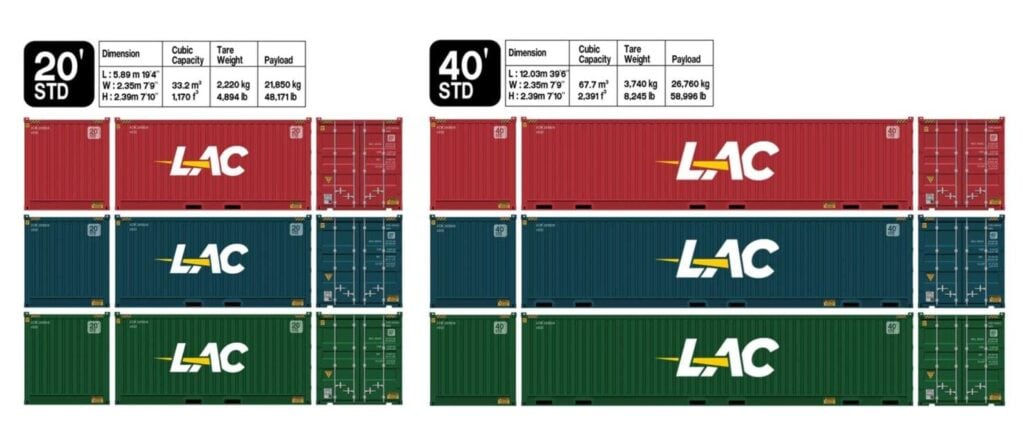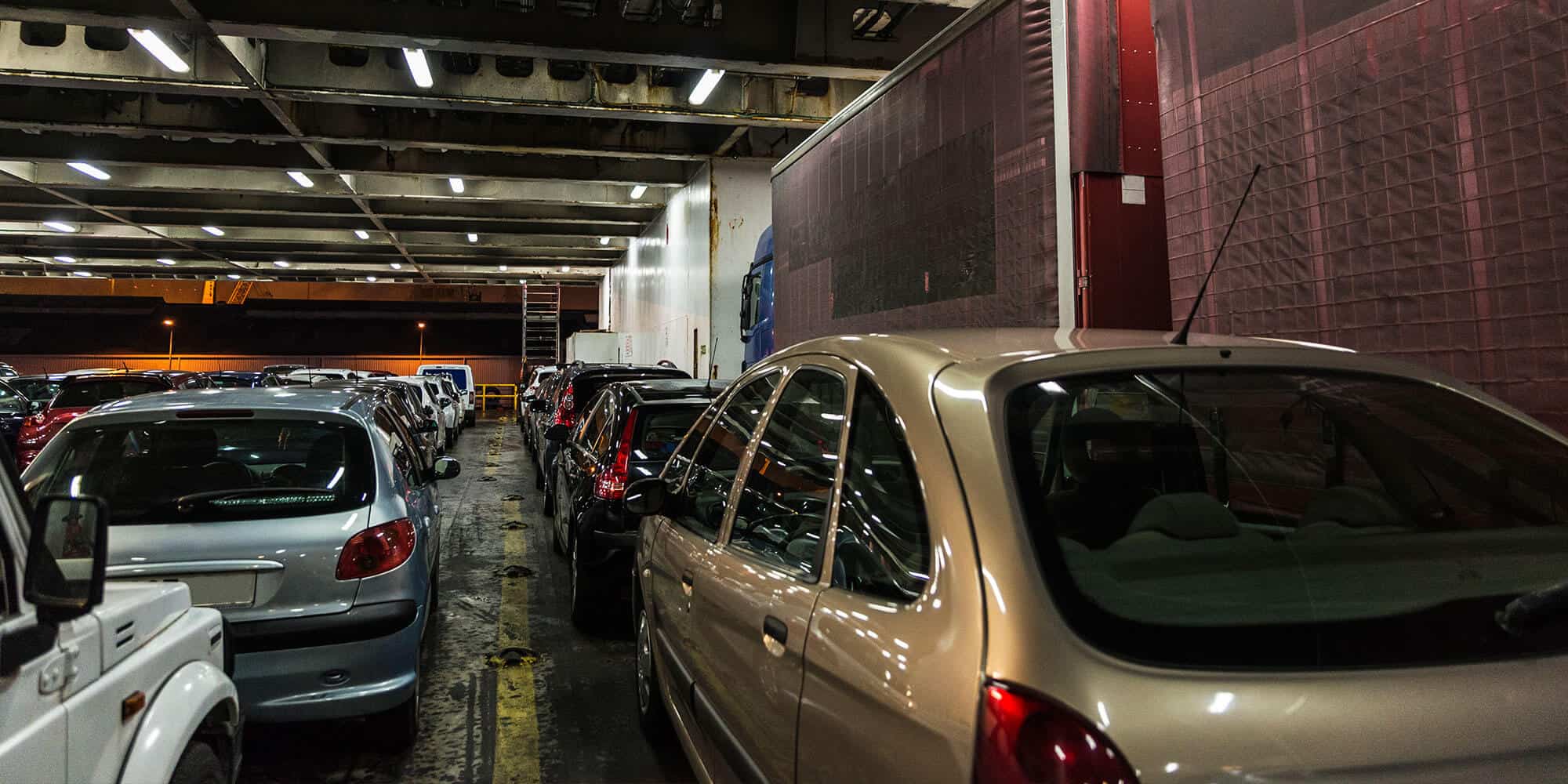When shipping internationally by sea, and having enough goods to fill up a whole container, a FCL shipment will be your most indicated option. The most commonly used type of shipping containers are named “Dry Storage Containers”. They come in different dimensions, standardized by ISO, with two main sizes: 20ft and 40ft container. Also known as general-purpose containers, they can store almost any kind of cargo from boxes, barrels, pallets, to vehicles and heavy equipment.
20ft and 40ft containers not only differ in terms of size, but maximum loading weight, usage, and cost. Depending on what your shipping requirements are, you will also find various other types of containers, from refrigerated to specialty containers, available in different shapes and sizes.
That is why you must pay special attention to the type and size of container selected for your shipment, as it not only helps ensure the safety of your freight but can also impact your budget.
Understanding Standard 20ft vs 40ft Container
Most companies only offer 20ft and 40ft containers. So, let’s first take a closer look at these two sizes of containers, how they are used, and how much cargo can fit in.
About Steel Containers and ISO Standards
Most shipping containers used today are made from steel or aluminum. They come with corrugated walls, hinged doors (on one, both, or all sides), and are welded to the end frames and rails.
They are required to meet certain standards and ISO requirements. The standard for these containers is ISO 6346:1995. This identification system gives each container a specific or unique marking. This code, however, can be broken into more parts: an ISO 6346 (BIC) code, a size code, and a type code, with the option to add additional markings.
Standard 20ft & 40ft Container Dimensions
40ft containers are also called Forty-foot Equivalent Units (or FEUs for short) and 20ft containers Twenty-foot Equivalent Units (TEUs). While their dimensions or size greatly differ, they offer the same level of strength.
20 feet Container Dimensions
- Length: 19’4″ / 5.89m.
- Width: 7’9″ / 2.35m.
- Height: 7’10” / 2.39m.
- Tare weight: 4,894 lbs / 2,220 kg.
- Payload capacity: 48,171 lbs / 21,850 kg.
- Cubic capacity: 1,170 ft³ / 33.2 m³.
40 feet Container Dimensions
- Length: 39’6″ / 12.03m.
- Width: 7’9″ / 2.35m.
- Height: 7’10” / 2.39m.
- Tare weight: 8,245 lbs / 3,740 kg.
- Payload capacity: 58,996 lbs / 26,760 kg.
- Cubic capacity: 2,391 ft³ / 67.7 m³.
*All dimensions are internal. 20ft and 40ft container dimensions can vary slightly by steamship line and manufacture.

20ft and 40ft containers differ in terms of dimensions, capacity, and maximum loading weight.
High Cube Containers Options
Those who want more space can go for a high cube container. These are similar to standard steel containers but taller. They offer a maximum height of 9’6″ or 8.96m.
High cube containers are available in both 20ft and 40ft sizes. You may also find some high cube containers that are 45′ long.
How Much Can I Fit in a 20ft vs a 40ft Container?
A 40’ container can fit more than twice what a 20’ container can fit:
- In a 20ft Container
A 20ft container can hold a total of 11 Euro-Pallets (1.2m x 0.8m), or up to 10 standard pallets in one-tier. - In a 40ft Container
A 20ft container can hold a total of 24 Euro-Pallets (1.2m x 0.8m), or up to 21 standard pallets in one-tier.
How to Choose Between 20′ and 40′? 3 things to keep in mind
Loading space is not the only factor to consider when selecting the size of your container. If you want to make a budget-friendly, transport-efficient decision, there are some facts that you have to take into consideration.
1. Cost
The first fact to consider is that 20ft containers are not more cost-efficient than 40ft containers. Contrary to popular belief, a 20ft does not cost half of a 40ft. The usual price for a 20ft container is around 75% of a 40ft container. There can be some ways to save money based on what you are shipping and where. Get in touch with us today to get a quote.
2. Loading & Storage
Bigger containers offer more space, that is why you should consider your storage and loading requirements when choosing a shipping container. As a rule, when shipping pallets in a container, we strongly suggest loading them in one row along the container’s length and another row along the width. Pallets can be easily stacked. However, if the merchandise is heavy, stacking may not always be recommended, which may change your container size requirements.
To efficiently use your containers, you need to carefully consider the volume and the height of your cargo. To accommodate bigger or taller items, you may choose a high cube container. It increases height by 27cm, adding up to a total extra volume of 9cbm. The extra height offered could save you from having to book an additional shipment.
3. Weight vs Volume
Each container is designed to carry specific cargo based on factors such as weight to volume ratio and weight distribution. If you plan on shipping heavy loads, keep in mind that you may not be able to utilize all the available space of the container.
This is one of the reasons why 20′ containers are more suitable to transport dense items and heavy cargo such as machinery, metals, cement, and sugar. And it might not be the best option for voluminous cargo due to limited space.
For such shipments as furniture or steel pipes, a 40′ container is usually the best option. A 40’ container cannot handle twice the amount of weight a 20’ container can; however, it can fit more than double the volume.
Here’s a generic example for a better understanding:
- a 20′ container can pack up to 1.53 m³ of cargo for every ton of weight. Up to 21.85 tons of cargo can be loaded on a 20′ container that offers only 33.50 m³ of cargo space.
- a 40′ container can pack up to 2.53 m³ of cargo for every ton of weight. Only 26.76 tons of cargo can be loaded on a 40′ container that offers up to 67.70 m³ of cargo space.
We must also mention that while high cube containers offer more volume (76m³ of cargo can be loaded), weight capacity is fixed at around 26.80 tons, same as a standard 40ft container.
20ft vs 40ft Container? What About Other Options?
Technically speaking, a 40ft container is almost always a better option as it offers more space, but that is not the only benefit. There can be loading and timing issues with 20ft containers as they can run some delays when sent by train or truck to reach the cargo vessel. 20ft containers are usually mounted on the rail by pairs.
Do not forget that in some cases, dry storage containers may not be possible to use if you have specific requirements for your cargo: temperature-regulated containers or open-top containers for specific goods. These containers are available in different sizes and are suitable for specific products. For more information, please take a look at our Containers Guide.
When shipping containers overseas, make sure to choose your freight forwarder carefully since their expertise and knowledge will directly affect the effectiveness of your business.
![]()
Contact Latin American Cargo today, our team of experts will bring you the best freight solutions and help you pick the right container for your shipment.


 LAC Team
LAC Team


